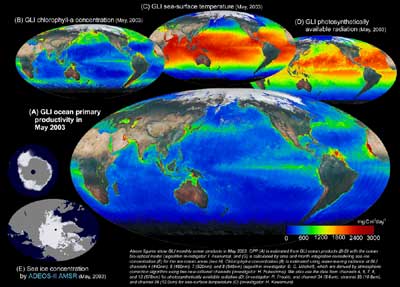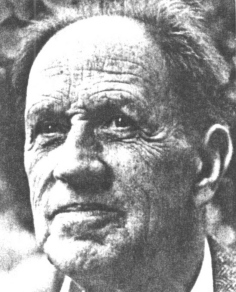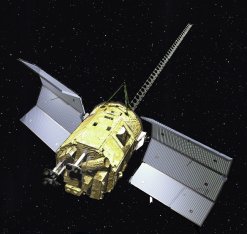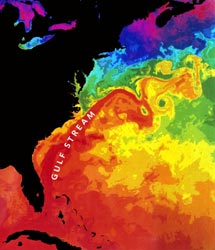

|
|
Due to the required 3-year rotation of IOCCG Committee members, Dr. Yongseung Kim (Korean Aerospace Research Institute) will step down from the Committee and will be replaced by Dr. Yu-Hwan Ahn of the Korea Ocean Research and Development Institute (KORDI). We'd like to welcome Dr. Ahn on the IOCCG Committee, and look forward to his contribution.
IOCCG will help to co-sponsor the second ANTARES workshop, which is scheduled to take place on 'Isla Margarita' (Venezuela) just before or after the 10th IOCCG meeting (19-21 January 2005). ANTARES is a collaborative coastal observing network for South America, established at an IOCCG-sponsored workshop in Mar del Plata, Argentina last July. The objectives of the ANTARES network are to examine the bio-optics of phytoplankton populations at a number of time series stations around South America. Long term changes in these coastal ecosystems will be investigated, including changes due to external perturbations (climate change and anthropogenic effects). The second ANTARES workshop will focus on remote sensing aspects as well as basic strategies for the in situ time series network. The quality of the satellite data obtained from the IAI project will be reviewed, and in situ validation programs will be developed. The group will discuss the number and type of core measurements to be taken at time series stations, and agree upon protocols and instrumentation to be used to collect these measurements.
IOCCG will be sponsoring a short course on ocean colour, immediately preceding the Ocean Optics XVII conference in Fremantle, Australia (25-29 October 2004). The course will be presented by Drs. Mervyn Lynch and co-workers, and is entitled "The Physical and Biological Basis of Ocean Colour Remote Sensing ". The aim of the course is to provide students who are new to the remote sensing field with a comprehensive overview of the basic scientific principles that underpin the discipline. Students will gain an understanding of processes occurring in the water column (light attenuation, absorption and scattering) that contribute to the spectral radiances emerging from the water surface. See Ocean Optics Conference website for further details.

Towards the end of last year, the Japan Aerospace Exploration Agency (JAXA) began releasing standard and higher level products derived from the Global Imager (GLI) onboard Midori-2, based on data acquired from April 2, 2003 to October 24, 2003. See GLI website for further information on the products. A number of interesting applications of this data can be found on the Earth Observation Research and Application (EORC) website, including an estimate of global Ocean Primary Productivity (OPP). According to this study, OPP tends to be higher around coastal areas in mid- to high latitudes, and also along the equator. OPP was estimated from the concentration of chlorophyll-a, sea-surface temperature, photosynthetically available radiation and ocean bio-optical models (using an algorithm developed by Dr. Ichio Asanuma of JAMSTEC).

After eight years in orbit, the highly successful MOS/IRS-P3 mission (developed by DLR, Germany) was officially terminated on 31 May 2004. MOS was the first of the "new generation" of ocean-colour sensors to be launched after CZCS, which was an opportune time to test retrieval and interpretation concepts developed after the CZCS-era. Despite the fact that the mission was designed to last only for 2 years, it operated continuously and efficiently for 8 years and produced a wealth of ocean-colour data. Much of the pioneering work on interpretation of ocean-colour data using the principal components approach and neural network analysis was carried out using MOS data.
To a great little ocean-colour satellite we say "Good bye and thanks for all the data!"
For more information see the DLR Web Portal (in German).
 The prominent marine ecologist, Prof. Ramon Margalef, passed away at his home in Barcelona, Spain on May 23, 2004. Prof. Margalef was one of the great pioneers in the study of plankton succession and the role of physical processes in structuring plankton communities. He also pioneered the use of multidimensional statistical analyses in wider studies of marine plankton. His contributions to theoretical ecology have brought him high international prestige, in the form of numerous awards such as the ASLO Lifetime Achievement Award (2000), the International Ecology Institute (ECI) prize (1995), and the Bedford Institute of Oceanography Huntsman Award (1980). Margalef was a prolific writer, publishing hundreds of papers, many of which are classics and continue to inspire models of ecosystem dynamics. He also wrote many books and monographs which have made him one of the most frequently cited contemporary ecologists.
|

The SAC-C satellite, launched in November 2000, is the first operational Argentinian satellite for Earth observation. SAC-C is an international mission conceived as a partnership between the Argentinian National Commission on Space Activities (CONAE) and NASA, with additional support in instrumentation and satellite development from the Danish (DSRI), Italian (ASI), French (CNES) and Brazilian (INPE) Space Agencies. There are ten instruments on board SAC-C, and among them is the Multispectral Medium Resolution Scanner (MMRS), provided by CONAE. The MMRS sensor has been used for evaluating desertification processes in Patagonia and Argentina, as well as identifying and predicting agriculture production, monitoring flooded areas and studying coastal and fluvial areas. The MMRS is associated with a High Resolution Technological Camera (HRTC), also provided by CONAE, which helps to enhance MMRS resolution in selected areas . A High Sensitivity Technological Camera (HSTC) is also included in the mission and provided by CONAE. MMRS acquires data in fives spectral bands (480-500 nm, 540-560 nm, 630-690 nm, 795-835 nm and 1550-1700 nm) with a spatial resolution of 175 meters and a 9-day repeat cycle. This camera can operate in real time at a bit rate of 3.774 Mbit/sec and can also store data in its own memory with an image dimension of 360 km x 8000 km (depending on the data compression ratio). Argentinian researcher, Dr. Domingo Antonio Gagliardini, from Centro Nacional Patagonico (CENPAT), has been successfully processing the data into ocean-colour products (see example below). Quick looks of the acquired images can be found on CONAE´s web page catalogue, which is updated daily.
 Real time MMRS image (Bands 1, 2 and 3) of the Patagonian coast, showing a phytoplankton bloom (in yellow). Courtesy of Domingo Antonio Gagliardini (CENPAT) and Raul Colomb (CONAE).
MODIS-Aqua Processing
The complete mission reprocessing of the MODIS-Aqua data set has been completed and all products are available for download via NASA's Oceancolor Web. A new product for MODIS-Aqua data has been added - a quicklook global daily 4 km and 9 km Level-3 image and hdf files for the current standard product set (chlorophyll, sea surface temperature, diffuse attenuation, nLw at 551 nm, aerosol optical thickness and Angstrom coefficient). All the files are available for download from the level-3 browser: http://oceancolor.gsfc.nasa.gov/cgi/level3.pl
MODIS Science Team meeting
Online Registration has begun for the MODIS Science Team meeting, which will take place from 13-15 July 2004. If you are interested in attending, please be sure to sign up at http://modis.gsfc.nasa.gov/sci_team/meetings/200407/index.html before July 6, 2004. During the meeting there will be a number of presentations by MODIS Science Team members, as well as poster sessions and discussions. Representatives from NOAA/NESDIS will also describe plans for transitioning MODIS products into an operational status. A preliminary meeting Agenda will be available soon.
 Several new references have been added to the Recent Ocean-Colour References section of the IOCCG website, including one by Stephanie E. Schollaert, Thomas Rossby, and James Yoder, which appeared in the current SeaWiFS special issue of Deep Sea Research II. The paper is entitled "Gulf Stream Cross-Frontal Exchange: Possible Mechanisms to Explain Interannual Variations in Phytoplankton Chlorophyll in the Slope Sea during SeaWiFS Years". In this study the authors describe their four-year, NASA-funded study of the Slope Sea (north of the Gulf Stream) in order to understand the processes that control the yearly variability of surface chlorophyll concentrations. The supply of cold, fresh Labrador Sea water to the Slope Sea influences the path of the Gulf Stream, pushing it further south in the spring. Surface temperature and salinity increased in the Slope Sea over the first four years of the SeaWiFS mission, and surprisingly there was a collective increase in phytoplankton chlorophyll in this region, contrary to the commonly observed inverse relationship between temperature and chlorophyll. The authors also found that the Labrador Current is not the major supplier of nutrients, but rather that the Slope Sea receives a steady nutrient supply from the sub-surface Gulf Stream waters. Understanding how the north-south movement of the Gulf Stream affects biological productivity in the Slope Sea will help scientists make inferences about large-scale, low frequency climatic effects upon the carbon cycle of ocean margin waters. If you would like to see your references added to the IOCCG bibliography, please submit them to the Project Officer.
A number of new positions in remote sensing have been added to the IOCCG Employment Opportunities section. See also the Training and Education section, for the 2004 START Young Scientist Award Program. Scholarships are also available for study at Dominica's Institute for Tropical Marine Ecology.
|
|
Material for possible inclusion in the IOCCG Newsletter should be submitted to the Project Scientist. Subscription to the IOCCG Mailing List.Participants receive a brief summary of the IOCCG Newsletter by e-mail (bi-monthly), as well as hard copies of IOCCG Reports as and when they become available. Subscribe to mailing list (Please include your name, address and email address in the body of the message.) Unsubscribe from mailing list
|
|
|
|